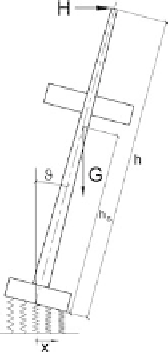Environmental Engineering Reference
In-Depth Information
Fig. 4.3 Elastically bedded tower foundation
Substituting for M
1
and M
2
results in the following rearranged equation:
H
h
¼ð
k
s
I
found
G
h
s
Þq
In this equation the action effect is on the left, the resistance on the right. A stable condition
is only achieved when the expression in the brackets is positive, that is
h
s
<
k
s
I
found
=
G
Introducing the settlement due to dead load here, that is s
¼
G/(k
s
A
found
), allows the
upper bound of the centroid position to be estimated as follows:
h
s
<
I
found
=ð
s
A
found
Þ
The foundation modulus k
s
, or the settlement s, should be estimated carefully, that is in
the form of the lower bound for concentric long-term action effects on the soil/structure
interface. In cases of doubt, a deep foundation should be chosen instead of a flexible
spread foundation.
4.3 Investigating vibrations
The structural analysis of a tower begins with an analysis of the vibrations. The
methods of classical vibration theory are available for this, which are based on the
differential equation for the mass-spring system with a single degree of freedom.
The practical methods that can be used are the modal analysis of the mass-spring
system with multiple degrees of freedom or, when only the first eigenmode is required,
simplified approaches according to the principle of conservation of energy.
4.3.1 Mass-spring systems with single/multiple degrees of freedom
The model of the mass-spring system with a single degree of freedom can be used to
determine the period of oscillation of the fundamental frequency of a wind turbine


